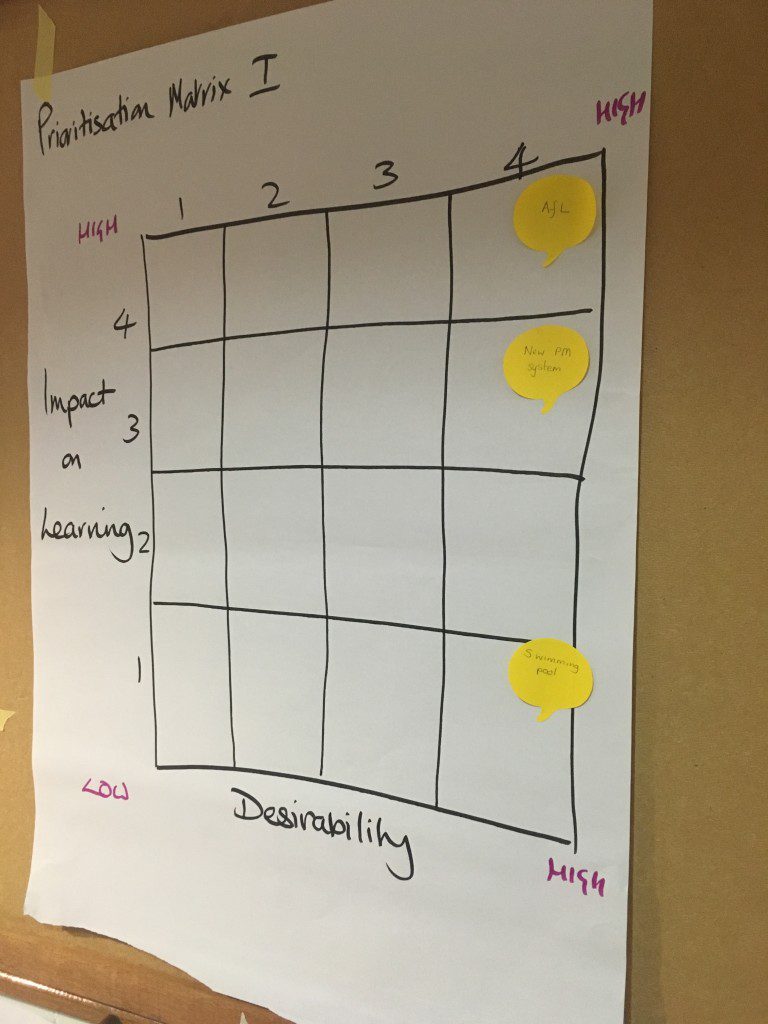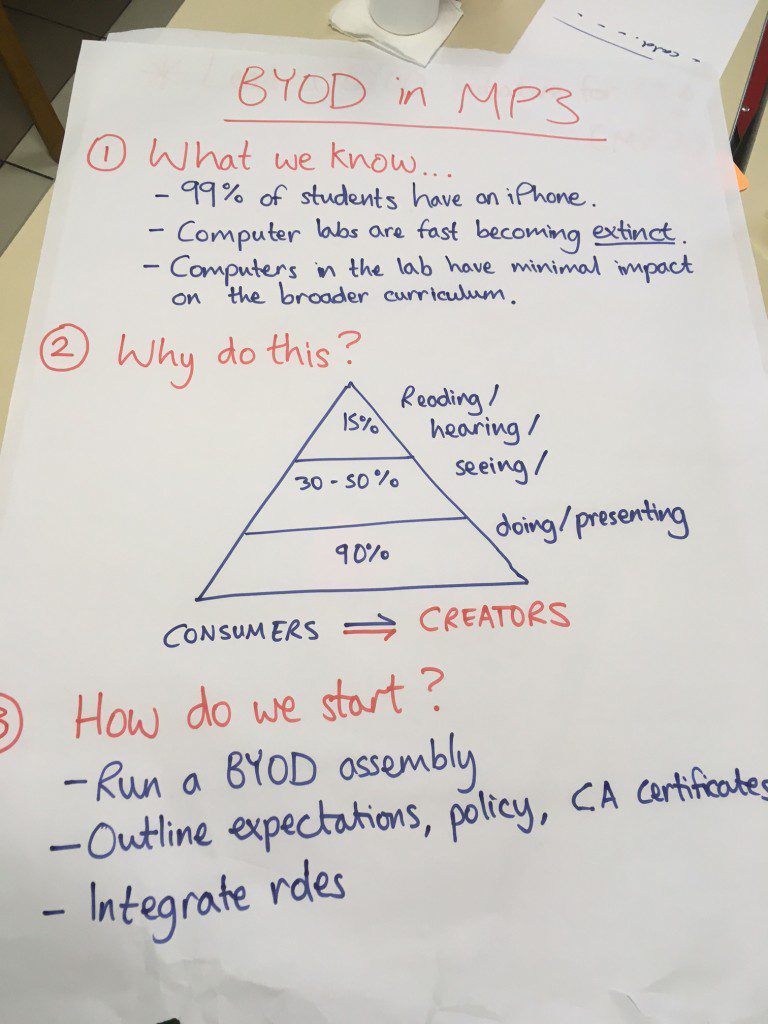During our TBS Conference the other week, I attended a 4-day leadership course delivered by Karen Ardley Associates. As the course was specifically tailored for middle leaders, I came away with many practical insights that I could readily apply to my own role as a curriculum coordinator and line manager. The purpose of this post is just to summarise my reflections and key actionable takeaways from the four days.
DAY 1 – All about you as a leader
The course began with an emotional intelligence (EI) self-analysis, which I found to be a valuable tool in order to highlight my EI strengths and consider areas for further development. According to Karen Ardley, emotional intelligence “is the ability to understand, use and manage our own emotions and respond to the emotions of others, in constructive and purposeful ways.” The importance of emotional intelligence as a factor for creating better leaders became even more clear to me after listening to Ben Walden‘s keynote speech, when one point stood out – we cannot show leadership for others when we are not living it in our own lives.
Apparently, emotional intelligence makes up two-thirds of effective job performance – only one third is cognitive and technical ability. In terms of self awareness and management, we need to ensure that we manage our emotions in order to control our behaviours. A key point made on the course was that the first step to developing positive leadership behaviours is to control our self talk. Optimism, it would seem, is a key characteristic of the best leaders. Numerous studies support this assertion, along with other benefits such as better health and increased longevity. The Nun Study was used as one particularly interesting example, showing that nuns who expressed more positive emotions lived, on average, a decade longer than their less optimistic peers and they were far less likely to develop Alzheimer’s disease.
The discussion about emotional intelligence and leadership then neatly led onto looking at Benjamin Zander’s work:
Using the orchestra as an analogy for leadership, one of my main takeaways from Benjamin Zander’s TED talk is the idea that the conductor never makes a sound. In other words, the best leaders inspire leadership in others – and we can see it’s working for our audience because of their “shining eyes”. As Benjamin Zander explains, ‘The eyes never lie. If the eyes are shining, then I know that my leadership is working.’
As a conductor of an orchestra, I realised the music was beautiful and I wasn’t making a sound.
The conductor who does not make a sound can focus on making others more powerful. This makes sense: if people you’re managing feel lively, energetic and connected, they’re more likely to perform at their best.
DAY 2 – Leading and developing others
The second day began with a quote by the British researcher and management theorist, Meredith Belbin:
Nobody’s perfect but a team can be.
This, along with mention of Bill Gates’ emphasis on developing the best teams, set the foundation for introducing the idea of a high-performing team. According to Karen, a high performing team:
– achieves high levels of leadership confidence
– build its capacity to implement change effectively
– nurtures energy and enthusiasm for learning and teaching
– develops and shares its knowledge, skills and expertise
– builds esteem of all members
In order to better understand how to develop a team and get to the high-performing stage faster, we studied Tuckman’s 4 stage model for team development:
At the forming stage, the leader needs to be directive – providing structure for the team and clarifying expectations about how the team process will be initiated.
During the storming stage, the leader coaches the group by helping them focus on the goals and expectations, managing process and conflict, generating ideas, and explaining decisions.
As the team enters the norming stage, the leader acts primarily as a facilitator by providing encouragement, helping to build consensus, and giving feedback.
Finally, at the performing stage, the leader still facilitates the team process, but tasks and objectives are delegated. The leader oversees and identifies when the group is moving to a different stage.
The Prioritisation Matrix


DAY 3 – Leading teaching and learning
As we looked at what made effective teams and successful initiatives, we naturally moved into a discussion about giving feedback. Research shows that oral feedback is potentially the most effective way of providing professional development and learning opportunities. Effective oral feedback has the following features:
– begins with something positive (a headline) – not “How do you think it went?”
– specific
– asks questions to develop understanding – aims for dialogue
– describes behaviours not the person
As an example of how oral feedback should be given, we watched this video, The Story of Austin’s Butterfly by Ron Berger:
In order to receive feedback effectively, the following points were identified:
– listen to the feedback carefully before responding
– be careful you fully understand what is being said
– ask questions for clarification and exploration
– seek other opinions rather than relying on one source
– decide what you will do as a result of the feedback
As leaders of teaching colleagues, we need to be particularly aware of using coaching strategies for developing teachers’ classroom practice. After watching two filmed lesson observations, the following coaching questions were used to assess the success of lessons and provide effective feedback for the teacher:
1. Did all students achieve the learning objective?
2. How do you know?
3. What will you do about those who didn’t?
4. How will you assess and use students’ prior knowledge?
5. How did you liaise with your teaching assistant before/during/after the lesson?
6. What can students do now that they couldn’t at the start of the lesson?
7. How did you make sure students know their next steps in learning?
8. How did you make sure all students know your high expectations?
9. How did you provide challenge for all your students?
10. Did the students enjoy the lesson and how do you know?
I like these ten questions because they have the power to refocus from problem to solution. Certainly, the need for effective feedback, especially for developing teachers, cannot be understated. In fact, our discussion about coaching and giving feedback to teachers reminded me of this excellent TED talk that Bill Gates gave on the subject:
After studying the theory of coaching and feedback, we were given a practical exercise to do. Working in pairs, we were asked to think about an important issue we were facing and practise a role-playing exercise in which we took turns to play both the roles of coach and the person being coached. I found this to be a useful experience both in terms of getting feedback on my way of dealing with a particular issue and helping to clarify my own understanding of what makes a great coach.
The suggested coaching process to support professional development can be distilled into three stages (based on Gerard Egan’s Skilled Helper):
Stage 1 Analysis
Where am I now? What’s happening here?
Stage 2 Direction setting
Where do I want to be?
Stage 3 Action planning
How will I get there?
Clearly, asking the right questions is a fundamental technique for guiding the person that you are coaching, so that they can find their own solution. This in itself can be a powerful way of unlocking leadership potential in others. As Karen explained, it is not the role of the coach to provide answers or to give advice, but to support the development and learning of the professional learner – to inspire self-directed change. In order to develop coaching skills further, it is important to become increasingly committed to:
– understanding one’s own learning needs
– reflecting on one’s practice
– taking an ever-more active role in one’s own learning and the learning of others
– acting on what is learned to improve student learning
DAY 4 – Practising leadership
On the last day, we looked at what made effective meetings, strategies for dealing with challenging people and, for the last activity, we were asked to deliver a 10-minute presentation about an initiative that we wanted to introduce.
Meetings
As obvious (or not) as it may sound, the best meetings are fun and enjoyable. Essentially, they are conversations that lead to action – they are not about information giving. We had the opportunity to experience this by getting into groups and engaging in a role-play of a ‘high energy’ meeting. This required a clear and purposeful agenda (timed, prioritised), ground rules (listen with an open mind, encourage everyone to participate) and the use of relevant materials (post-its, pens, paper, etc.)
Following a meeting, for larger teams, Karen showed us this method of using dot stickers to quickly gauge and visually represent the popularity of the team’s preference when there are two or more possible options over an issue. In this hypothetical example, we were asked about our preference regarding when to hold a team meeting. We needed to use three stickers for our strongest preference, two stickers for our second best choice and one (or no stickers) for our least desired choice.For larger teams, Karen showed us this method of using dot stickers to quickly gauge and visually represent the popularity of the team’s preference when there are two or more possible options over an issue. In this hypothetical example, we were asked about our preference regarding when to hold a team meeting. We needed to use three stickers for our strongest preference, two stickers for our second best choice and one (or no stickers) for our least desired choice.
Challenging people
I found the advice about how to deal with challenging behaviours useful. For difficult conversations for example, the following suggestions were provided:
– Choose the location
– Plan and script
– Predict likely responses
– Use assertive statements
– Think win:win
Lauren Mackler from Harvard Business School also has some great tips about how to manage difficult conversations:
Presentation
For the last activity, we each had to prepare a presentation to be presented to other members of our group and someone from senior leadership. This activity was a surprise and, having only an hour to prepare, I enjoyed the challenge of presenting an initiative that I wanted to lead. Using just a Flipchart and pen, it was also a good exercise to present without the use of any digital technology!

Personally, I like to follow a simple three-step process to presentations: what, why and how. The ‘what’ sets both the purpose and context for the presentation. The ‘why’ helps to engage the audience by giving them a reason why they should care. Finally, the ‘how’ provides the explanation about how the initiative will be developed. I find that following this structure helps to give a presentation clarity and organisation.
As always, with any activity like this, the most useful part is to get feedback. In our group, we each took turns presenting and then watching and evaluating the presentations of our peers. We evaluated aspects such as control of space, use of voice and body language. Based on my own feedback, I had communicated my message well – I just need to remember to smile more! 🙂
It is also worth mentioning that when it comes to presentations, less is more. The simpler and more succinct you can make your message, the better. After all, as both teachers and students, we know that we all have limited cognitive loads at any one time. By making your message easier to absorb, it becomes more memorable, and ultimately, more likely to be acted upon.
Concluding thoughts…
By the end of this 4-day leadership course, I felt that I had gained a much better insight into my own strengths and areas of development as a leader. I was especially happy to come away with so many practical leadership ideas and strategies. One of the key messages, I believe, is that the best leaders are positive and inspire leadership in others through effective coaching and feedback strategies.





